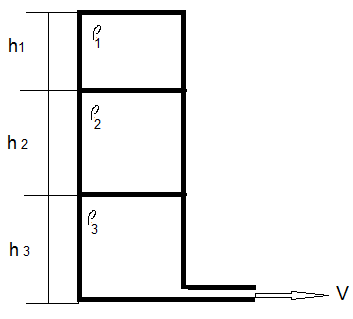Question

a.
\(\sqrt{2g(h_1 + h_2 + h_3)}\)
b.
\(\sqrt{2g(\frac{ρ_1h_1+2ρ_2h_2+3ρ_3h_3}{ρ_1})}\)
c.
\(\sqrt{2g(\frac{ρ_1h_1+\frac{1}{2}ρ_2h_2+\frac{1}{3}ρ_3h_3}{ρ_2})}\)
d.
\(\sqrt{2g(\frac{ρ_1h_1+ρ_2h_2+ρ_3h_3}{ρ_3})}\)
Posted under Fluid Mechanics
Interact with the Community - Share Your Thoughts
Uncertain About the Answer? Seek Clarification Here.
Understand the Explanation? Include it Here.
Q. A large tank is filled with three liquids of densities ρ₁, ρ₂ and ρ₃ up to heights of h₁, h₂ and h₃ respectively. What will be the expression for the instantaneous velocity of...
Similar Questions
Explore Relevant Multiple Choice Questions (MCQs)
Q. A gate of length 5 m is hinged at A as shown to support a water column of height 2.5 m. What should be the minimum mass per unit width of the gate to keep it closed?
View solution
Q. A container is filled with two liquids of densities ρ and 2ρ up to heights h and eh respectively. What will be the ratio of the depths of the centres of pressure of the upper face BC and the lower face AB?
View solution
Q. A container is filled with two liquids of densities ρ and 2ρ up to heights h and 2h respectively. What will be the ratio of the total pressure on the lower face AB and on the upper face BC?
View solution
Q. A container is filled with two liquids of densities ρ₁ and ρ₂ up to heights h₁ and h₂ respectively. What will be the hydrostatic force (in kN) per unit width of the lower face AB?
View solution
Q. A square lamina (each side equal to 2m) is submerged vertically in water such that the upper edge of the lamina is at a depth of 0.5 m from the water surface. If the pressure on the surface is 12 bar, what will be the total water pressure (in kN) on the lamina?
View solution
Q. The highest and lowest vertices of a diagonal of a square lamina (each side equal to 4m) are 1 m and 3 m respectively as shown. What will be the depth (in m) of it’s centre of pressure?
View solution
Q. The highest and lowest vertices of a diagonal of a square lamina (each side equal to 4m) are 1 m and 3 m respectively as shown. What will be the water force (in kN) on the lamina?
View solution
Q. The greatest and the least depth of a circular plate of 4 m diameter from the free surface of water are 3m and 1 m respectively as shown. What will be the depth (in m) of it’s centre of pressure?
View solution
Q. The greatest and the least depth of a circular plate of 4 m diameter from the free surface of water are 3 m and 1 m respectively as shown. What will be the total pressure in (kN) on the plate?
View solution
Q. What will be the depth (in m) of the centre of pressure for a vertical square lamina submerged in a tank of oil (S=0.8) as shown in the figure?
View solution
Q. The upper and lower edges of a square lamina of length 4 m are at a depths of 1 m and 3 m respectively in water. What will be the total pressure (in kN) on the lamina?
View solution
Q. The upper and lower edges of a square lamina of length 4 m are at a depths of 1 m and 3 m respectively in water. What will be the depth (in m) of the centre of pressure?
View solution
Q. What will be the total pressure (in kN) on a vertical square lamina submerged in a tank of oil (S=0.9) as shown in the figure?
View solution
Q. A square lamina (each side equal to 2m) is submerged vertically in water such that the upper edge of the lamina is at a depth of 0.5 m from the free surface. What will be the depth (in m) of the centre of pressure?
View solution
Q. A square lamina (each side equal to 2m) with a central hole of diameter 1m is submerged vertically in water such that the upper edge of the lamina is at a depth of 0.5 m from the free surface. What will be the total water pressure (in kN) on the lamina?
View solution
Q. A square lamina (each side equal to 2m) is submerged vertically in water such that the upper edge of the lamina is at a depth of 0.5 m from the free surface. What will be the total water pressure (in kN) on the lamina?
View solution
Q. If the tank is moving vertically, which of its component is subjected to maximum total pressure?
View solution
Q. There will be development of shear stress due to the dynamic motion of tank or container.
View solution
Q. The pressure intensity at the bottom remains same, even if the tank moves with constant horizontal acceleration.
View solution
Q. A tank containing water upto a depth of 650 mm is stationary. Find the force exerted by fluid of specific gravity 0.55 on the side of tank,width of tank is 1.5m
View solution
Recommended Subjects
Are you eager to expand your knowledge beyond Fluid Mechanics? We've handpicked a range of related categories that you might find intriguing.
Click on the categories below to discover a wealth of MCQs and enrich your understanding of various subjects. Happy exploring!








